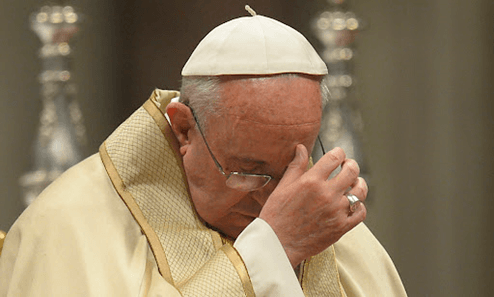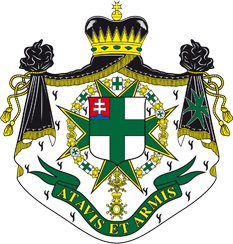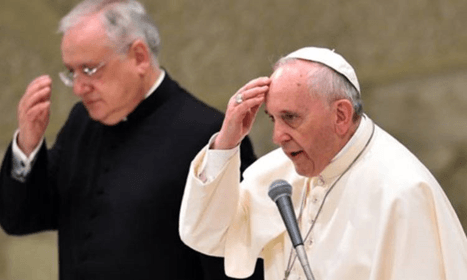Meditácia na Advent biskupa Roalda Nikolaja Flemestada , GCLJ, delegáta Scrantonskej únie pre Európu.
MEDITAZIONE PER L’AVVENTO DEL VESCOVO ROALD NIKOLAI FLEMESTAD, GCLJ, DELEGATO DELL’UNIONE DI SCRANTON PER L’EUROPA
Perché facciamo il segno della croce? Chiaramente, è un modo di aggiungere qualcosa alla preghiera verbale, sigillando con le dita. Allora chiediamoci: qual è il simbolismo intrinseco espresso in questo atto? Per capire il significato dobbiamo considerare che il segno della croce fino al Medioevo si faceva sulla fronte e non sul petto.
Con questo in mente le radici veterotestamentarie dell’usanza diventano chiare. Al profeta Ezechiele viene comandato da Dio di mettere „un segno sulla fronte di coloro che sospirano e gemono per le abominazioni che vengono commesse a Gerusalemme“ (Ez. 9:4). In questo contesto il marchio sulla fronte è un segno di pentimento e di protezione.
Un altro significato, più gioioso, è collegato a questa usanza. I pii ebrei si segnavano sulla fronte l’ultima lettera dell’alfabeto come simbolo della gloria di Dio. L’ultima lettera simboleggia la pienezza e la perfezione della creazione di Dio. Nell’ebraico antico l’ultima lettera, tav, era scritta come + e più tardi come T. Questo simbolismo è espresso anche nel greco arcaico dove la lettera T è scritta o come + o come X.
Di nuovo ci viene ricordato questo simbolismo di lettere nell’Apocalisse quando il Cristo risorto è chiamato „l’Alfa e l’Omega, il principio e la fine, il Primo e l’Ultimo“ ( 22:13). Tuttavia, il simbolismo delle lettere non era usato solo per esprimere la gloria di Cristo. Segnando la fronte con la lettera T o +, cioè la croce, i giudeo-cristiani della Chiesa primitiva confermavano allo stesso tempo la loro fede e testimoniavano al mondo che vivevano nella nuova realtà della risurrezione di Cristo. Così il marchio sulla fronte simboleggiava la croce di Cristo come segno di pentimento e serviva anche come espressione della gioia della salvezza.
Ora questo doppio significato si riflette anche nel rituale battesimale come San Cirillo di Gerusalemme spiega il significato dell'“unzione della fronte“ ai catecumeni: „Grande davvero è il battesimo che vi viene offerto. Esso è il riscatto dei prigionieri; la remissione delle offese; la morte del peccato; la rigenerazione dell’anima; la veste di luce; il santo sigillo indelebile“ (Catechesi Mistagogiche III, 16, Protocatechesi 16). Infatti, la comprensione del battesimo come un’unzione e un sigillo nello Spirito è di uso comune tra i Padri della Chiesa, ma è già stata usata da San Paolo e anche dall’Apocalisse (2 Cor. 1:21 f; Ef. 1:13 -15; Apoc. 7:4).
San Giovanni Crisostomo incoraggia i fedeli a farsi il segno della croce con queste parole: „Quando, dunque, ti fai il segno della croce sulla fronte, armati di una santa audacia e reinserisci la tua anima nella sua vecchia libertà; perché non ignori che la croce è un premio oltre ogni prezzo. Considera qual è il prezzo dato per il tuo riscatto, e non sarai mai più schiavo di nessun uomo sulla terra. Questa ricompensa e riscatto è la croce. Non devi quindi fare il segno sulla fronte con noncuranza, ma devi imprimerlo nel tuo cuore con l’amore di una fede fervente. Niente di impuro oserà molestarvi vedendo l’arma che vince ogni cosa“.
Un ulteriore significato del marchio è la protezione e il servizio. Dopo il sigillo battesimale apparteniamo al Signore come sua proprietà. Siamo come pecore marchiate con il marchio del Buon Pastore, come soldati che portano il marchio del Re. Il sigillo battesimale è un segno del nostro arruolamento nel Suo esercito. Questa comprensione del sigillo battesimale è ripetutamente usata dai Padri della Chiesa.
Le metafore della proprietà e del servizio ci sono particolarmente utili per comprendere anche il tempo dell’Avvento. La parola „avvento“ deriva dalla terminologia militare che significa originariamente „ispezione“. Così, l’Avvento è il tempo stabilito per coloro che portano il marchio del Re. Essi si preparano alla venuta del Signore. Lo facciamo segnandoci umilmente con un segno di pentimento e allo stesso tempo sapendo che in Cristo siamo protetti con un sigillo santo indissolubile. In breve, facciamo il segno della croce perché apparteniamo a Cristo Re.
MEDITATION FOR ADVENT BY BISHOP ROALD NIKOLAI FLEMESTAD, GCLJ, SCRANTON UNION DELEGATE FOR EUROPE

Why do we make the sign of the cross? Clearly, it is a way of adding to the verbal prayer by sealing with our fingers. So let us ask what is the inherent symbolism expressed in this act? In order to understand the significance we must take into consideration that the sign of the cross until the Middle Ages was made on the forehead and not over the breast.
With this in mind the Old Testament roots of the custom becomes clear. The prophet Ezekiel is commanded by God to put «a mark on the forehead of those who sigh and groan over the abominations that are committed in Jerusalem» (Ez. 9:4). In this context the mark on the forehead is a sign of repentance and protection.
Yet another, more joyous meaning, is also connected with this custom. Pious Jews would mark themselves on the brow with the last letter of the alphabet as a symbol of God’s glory. The last letter is to symbolise the fullness and perfection of God’s creation. In Old Hebrew the last letter, tav, was written as + and later as T. This symbolism is also expressed in archaic Greek where the letter T is written either as + or as X.
Again we are reminded of this letter symbolism in the Apocalypse when the risen Christ is called «the Alpha and the Omega, the beginning and the End, the First and the Last» ( 22:13). However, the letter symbolism was not only used to express Christ’s glory. Marking the forehead with the letter T or +, that is the cross, Judeo-Christians in the Early Church at the same time confirmed their faith and witnessed to the world that they lived in the new reality of the Resurrection of Christ. Thus the mark on the forehead would symbolise the cross of Christ as a sign of repentance and also serve as an expression of the joy of salvation.
Now this double meaning is also reflected in the baptismal ritual as St Cyril of Jerusalem explains the meaning of «the anointing of the forehead» to the cathecumens: «Great indeed is the baptism which is offered you. It is the ransom to captives; the remissions of offences; the death of sin; the regeneration of the soul; the garment of light; the holy indelible seal» (Mystagogical Catechises III:16, Protocatechesis 16). In fact, the understanding of baptism as an anointing and a sealing in the Spirit is common usage among the Church Fathers but has already been used by St Paul and also the Apocalypse (2 Cor. 1:21 f; Eph. 1:13 -15; Apoc. 7:4).
St. John Chrysostom encourages the faithful to cross themselves with these words: “When, then, you make the sign of the cross on the forehead, arm yourself with a saintly boldness, and reinstall your soul in its old liberty; for you are not ignorant that the cross is a prize beyond all price. Consider what is the price given for your ransom, and you will never more be slave to any man on earth. This reward and ransom is the cross. You should not then, carelessly make the sign on the forehead, but you should impress it on your heart with the love of a fervent faith. Nothing impure will dare to molest you on seeing the weapon, which overcometh all things.”
A further meaning of the marking is protection and service. After the baptismal sealing we belong to the Lord as his property. We are like sheep branded with the mark of the Good Shepherd, like soldiers bearing the mark of the King. The baptismal seal is a sign of our enlistment in His army. This understanding of the baptismal seal is repeatedly used by the Church Fathers.
The metaphors of ownership and service is especially of help to us in understanding also the time of Advent. The word «advent» stems from military terminology meaning originally «inspection». So, Advent is the time set a part for those bearing the mark of the King. They shall prepare themselves for the coming of the Lord. We do this humbly marking ourselves with a sign of repentance and at the same time knowing that we in Christ are protected with an indissoluble holy seal. In short, we make the sign of the cross because we belong to Christ the King.
UDALOSTI
- Grand Hospitaller Report 2023 27. júna 2024
- Podpora vzdelávacieho procesu na školách 7. júna 2024
- Investitúra 2024 25. mája 2024
- Pozvánka na investitúru 2024 17. mája 2024
- Charitatívna činnosť 15. mája 2024

 Military and Hospitaller Order of St.Lazarus of Jerusalem Grand Priory Slovakia,
Military and Hospitaller Order of St.Lazarus of Jerusalem Grand Priory Slovakia,